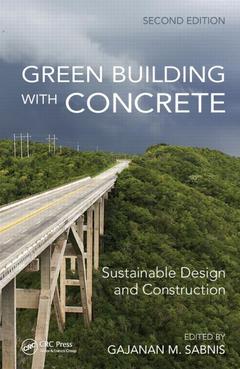Description
Green Building with Concrete (2nd Ed.)
Sustainable Design and Construction, Second Edition
Coordinator: Sabnis Gajanan M.
Language: English
Subjects for Green Building with Concrete:
Keywords
Urban Heat Island; Portland Cement; waste management; Fly Ash; Chemical Admixtures; sustainable building design; Energy Efficiency; concrete structures; Concrete Sustainability; green building; ICFs; LEED; Bottom Ash; ABU DHABI; Masdar City; Concrete Mixtures; Cement Industries; PC Pavement; Silica Fume; Thermal Mass of Concrete; RCC; Concrete Pavements; Heat Island; Roller-Compacted Concrete Pavements; FRP Wrapping; Pervious Concrete; Energy Savings; Sustainable Development; Pe Rc; Heat Island Effects; RCC Dam; Future Sustainable City; USGBC; Conventional Concrete; Global Sustainability; Inorganic Coatings; Sustainable Concrete; Foundry Sand; Postconsumer By-Product Materials; FRP Jacket; Steel Reinforcement; PC; Green Infrastructure; Greener Concrete; Industrial By-Product Materials; Coal-Combustion Products; Foundary Sand; Slag; Pulp; Paper Mill Residue; Alkali-Silica Reaction; Washed Water; RMC Plants; Post-Consumer Glass
· 15.6x23.4 cm · Hardback
Description
/li>Contents
/li>Readership
/li>Biography
/li>
Illustrates the Global Relevance of Sustainability
Applicable to roads, bridges, and other elements of the infrastructure, Green Building with Concrete: Sustainable Design and Construction, Second Edition provides an overview of all available information on the role of concrete in green building. A handbook offering viewpoints from worldwide experts on the global nature of the sustainability movement, it highlights research on economic analysis, in particular the International Organization for Standardization, Environmental Management?Life Cycle Assessment?Principles and Framework application of life cycle costing, to provide a full picture of the economic benefits of concrete in green building.
Outlines the Variety of Ways That Concrete Is Easily and Affordably Reused
With an emphasis on environmental impact and occupational and consumer health and safety, the text clearly outlines how to make the most of concrete in sustainable design. It explores the benefits of thermal mass, increased water supply, and improving water quality; reducing urban heat island effects; reducing construction waste; and the use of supplementary cementitious materials. The authors include an in-depth evaluation of carbon dioxide (CO2) and other emissions associated with the manufacture of cement. They also highlight the attributes that concrete has to offer the green building movement and the effect that emerging life cycle analysis has on concrete?s role in this important revolution in the building industry. Readers gain a better understanding of how concrete can contribute to sustainable construction, Leadership in Energy and Environmental Design (LEED), and the green building movement overall.
Green Building with Concrete: Sustainable Design and Construction, Second Edition presents the most recent information about concrete?s role in the green building movement, state-of-the-art methodologies, and best practices, and provides readers with diverse viewpoints on global sustainability.
Introduction. Sustainability in the Cement Industries and Chemical Admixtures. The Principles of Sustainable Building Design. Sustainability through Thermal Mass of Concrete. Concrete Pavements and Sustainability. Roller-Compacted Concrete Pavements. Pervious Concrete for Sustainable Development. Heat Island Effects. Future Sustainable City: The Case of Masdar City. Sustainability and Rehabilitation of Concrete Structures. Global Sustainability and Concrete. Sustainable Concrete with Industrial and Postconsumer By-Product Materials. Sustainability of Steel Reinforcement. Coatings for Creating Green Infrastructure. Materials’ Specifications: The Missing Link to Sustainability Planning.
Gajanan M. Sabnis, PhD, PE, is an international consultant and advisor to companies in the US and in India. He is an emeritus professor at Howard University in Washington, District of Columbia. With his diverse cultural background and experience in the United States and India, he spends considerable time in India to assist on infrastructure projects there. Dr. Sabnis is a strong proponent of sustainability in civil engineering. He participated in the initial development of the policy on sustainability in the American Society of Civil Engineers and has built his own home as an experiment following the principles of sustainable construction.




